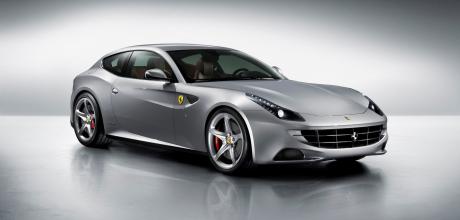First production car to feature Apple CarPlay - Ferrari FF 2014
Page through the CAR guide section at the back of the magazine and you’ll be hard-pressed to find a new model that does not incorporate some form of smartphone integration; be it simple Bluetooth connectivity, or touchscreen systems that accommodate Android Auto or Apple CarPlay functionality. And it was the latter that set the scene for the sort of phone-to- car interaction we enjoy in so many of our vehicles right now.
THE INNOVATORS
By the time the FF made its way onto the Ferrari stand at the 2014 Geneva Motor Show, the furore surrounding its combination of genre-blurring packaging, 483 kWV12 engine and placement as the first production-series AWD Ferrari at its 2011 debut had all but vanished. Now something even more remarkable nestled in the grand tourer’s belly … the first production iteration of Apple’s CarPlay system.
Apple’s foray into the world of automobile infotainment systems took place back in 2010 with the introduction of iPod Out in certain BMW models. This feature enabled access to specific applications on the iPhone 3G and 4 via the car’s iDrive controller, projecting an iOS4-based interface on the vehicle’s onboard touchscreen.
The next step was the introduction of Siri Eyes Free on selected Honda models in 2013. This setup integrated certain functions of Apple’s 2011 voice-activated assistant Siri into the voice-recognition systems aboard the likes of the Accord and Acura RDX/ILX models at the time. With Eyes Free, drivers could make phone calls, send text messages, set reminders and choose what music to listen to via voice prompts. You pressed and held a button on the radio, waited for a tone and spoke; Siri would then execute your command.
Between iPod Out and the commencement of the 2014 Geneva Auto Show, Apple had been quietly working on its next generation of automotive integration under the project codename Stark, with the tag line “iOS in the Car”.
Then, later that year, Ferrari introduced an updated FF model sporting Apple CarPlay. This system incorporated the voice-activated command architecture of Siri along with a touchscreen interface that roughly mirrored that of the iPhone. Now, with a host of apps at the end user’s disposal, the system could offer not only rich media and telephony, but also navigation, audio streaming and socialmedia functionality.
Apple revealed the latest iteration of CarPlay, which mines deeper than ever into the host car’s functionality. It can substitute factory-default displays on TFT screen-equipped cars for configurable digital instrumentation (fuel, speedo, infotainment and trip computer) as well as widgets for weather forecasts, extended communications, updated Apple Maps navigation and even an interface for the host vehicle’s climate control system.
While the idea of mobile phone integration may not set petrolheads’ hearts racing, the growing inseparability from our smartphones means its application to our cars is a monumental achievement. This will only grow in stature and functionality as the age of the internal combustion engine draws to a close.
THEY ALSO PAVED THE WAY
- 1981 HONDA ACCORD Predating GPS, the Accord’s helium-gas gyroscope-driven Electro Gyrocator featured interchangeable map transparencies and was a primitive precursor to the sat-nav systems widely employed today.
- 1986 BUICK RIVIERA The Delco-developed Graphic Control Centre in the Buick Riviera featured a mylarin-fused screen overseeing functions such as climate control and diagnostics as part of the first touchscreen infotainment system.
- 1990 TOYOTA SOARER With the advent of colour CRT screens in cars, the Soarer became the first production series vehicle to feature a reversing camera, a safety feature now mandatory on all new cars sold in the United States since 2018.
- 2015 HYUNDAI SONATA Only relegated to sidebar status owing to the one-year gap between it and the Ferrari FF, the Sonata’s place as the first car to feature Android Auto is nonetheless a grand achievement making it an automotive groundbreaker


